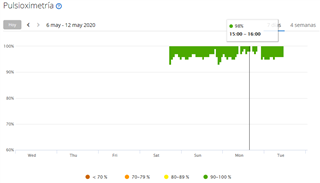I have compared to a high-end Nonin Pulse Ox and the 945 is at typically 4-5 points lower. I wish there was a way to calibrate this sensor.
My FR945 reads about 3 pts lower than my fingertip meter and my Fenix 5x plus. I have compared the F5x+ reading with a reading in the doctor's office several times and they were within 1 point each time…
My sleeping pulse ox seems to dip into high 80's/low 90's at certain times during the night...i can almost certainly confirm through my wife that i do not have sleep apnea. i think the dips happen…
Hummm... Hardly 3-6% below actual, at last for me... Look at the picture... Pulse-Ox usually between 93 and 99%... Often values around 96%... I don't have any medical device for this measurement, but I think can't would be so different than Garmin value. Garmin advertises its value has not medical meaning, so I think is OK. IMHO, of course.

how do you know its 3-6% below for you without any reference?
Saturation between 93-99% is totally fine.
The whole watch has no medical, but an athletical meaning. Also medical devices struggle under a lot of conditions, you would be surprised.
The best advice for accuracy: wear it above your wrist, not on the joint. Wear it tight. Relax your arm, don't contract your muscles reducing blood flow. Wear it dark. Sit or stand still.
In most use cases, one of the above conditions is not given.

My reading are also too low (mostly the same value as everyone else mentions).
Maybe just maybe it will show some value when I go snowboarding. Maybe just maybe even if particular readings are too low changes of consecutive readings will bring some info.
Summing it up: another useless feature looking good in ads (along with totally buggy Garmin Pay and awfully inaccurate OHR)
Tal vez me he expresado mal, o al intentar escribir en inglés, que no es mi idioma nativo, no he dicho lo que quería decir...
Yo pretendía indicar que -en mi opinión- los valores arrojados por el FR945 -en mi caso, repito- no pueden ser entre 3 y 6% más bajos de los "supuestamente reales", ya que si yo obtengo lecturas habitualmente del 96%, y a veces hasta de un 98 y 99%, si a eso le sumamos un 3-6% nos pasamos de 100.
Por otra parte, Garmin indica que tanto la medición de frecuencia cardíaca como la de pulsioximetría (es decir: todos los valores obtenidos en la muñeca) dependen de muchos factores: color de piel, temperatura, y hasta de cómo de suelto o de apretado llevemos el reloj.
En todo caso, no quiero polemizar, simplemente indicar que a algunos (yo creo que estoy entre ellos), los valores que el 945 nos indica parecen muy razonables, y desde luego yo no diría que están entre un 3 y un 6% por debajo de "los reales", porque si así fuera me saldría de la escala (entiendo que el valor máximo de SpO2 es 100, no?).
Saludos.
******************************************
Maybe I have expressed myself wrong, or when trying to write in English, which is not my native language, I have not said what I wanted to say ...
I wanted to indicate that -in my opinion- the values thrown by the FR945 -in my case, I repeat- cannot be between 3 and 6% lower than the "supposedly real", since if I usually obtain readings of 96%, and sometimes up to 98 and 99%, if we add 3-6% to that we go over 100.
On the other hand, Garmin indicates that both heart rate measurement and pulse oximetry (that is: all the values obtained on the wrist) depend on many factors: skin color, temperature, and even how loose or tight we wear the watch.
In any case, I do not want to argue, simply to indicate that to some (I believe that I am among them), the values that the 945 indicates to us seem very reasonable, and of course I would not say that they are between 3 and 6% below of "the real ones", because if that were the case I would go off the scale (I understand that the maximum value of SpO2 is 100, right?).
Regards.
Ah, now I understood. Being from Germany, im also a non-native "speaker".
You are absolutely right, the maximum of Spo2 is 100 wich means all the erythrocytes are saturated with O2 (or carbon monoxide, Garmins sensor can't separate).
I also think the numbers are reasonable (for me). I have seen the funny sticking 94% on the first Withings tracker wich had it way back in 2013/14. I had to laugh when the first Garmin watch also showed the 94% when it got no good reading.
In generell use, the area from 85 up to 100 is interesting, I would even say only between 90 and 100%. This means an error of only 1% is far bigger than it seems.
I would also like Garmin to chop the SpO2 charts off below 85%, there is no sportive use for it and it would scale a lot more readable. I understand it exaggerates small changes wich can lead to confusion, but now there is a lot of dead space on the lower 9/10 of the diagrams.

Did a couple little tests, it does appear that the tighter the strap the better the reading. Plus to keep it away from the wrist. However generally we keep our watches slightly loos due to feeling, however that just seems to be the way it is. I guess if you have your watch on the setting to take one off readings you could then at that point just push the watch slightly in to the wrist